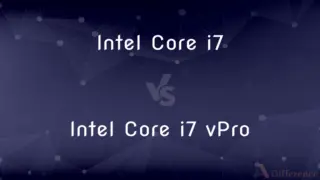BJT vs. MOSFET — What's the Difference?
Edited by Tayyaba Rehman — By Fiza Rafique — Published on December 12, 2023
BJT (Bipolar Junction Transistor) is a current-controlled device, while MOSFET (Metal-Oxide-Semiconductor Field-Effect Transistor) is voltage-controlled; both are used to amplify or switch electronic signals.

Difference Between BJT and MOSFET
Table of Contents
ADVERTISEMENT
Key Differences
BJT, short for Bipolar Junction Transistor, operates based on both electron and hole charge carriers. In contrast, the MOSFET, which stands for Metal-Oxide-Semiconductor Field-Effect Transistor, operates primarily through electron movement in enhancement mode and hole movement in depletion mode.
A fundamental distinction between BJT and MOSFET is their control mechanisms. BJT is a current-controlled device, meaning its operation is influenced by the input current. Conversely, MOSFET is a voltage-controlled device, with its function determined by input voltage.
When considering power consumption, BJT generally consumes more power than a MOSFET due to its current-driven nature. On the other hand, MOSFET, being voltage-driven, often operates with reduced power consumption, especially in the off-state.
From a construction perspective, BJT comprises two PN junctions, making it a three-layer device. MOSFET, meanwhile, is fabricated using metal (gate), oxide (insulator), and semiconductor material, making its name quite descriptive of its structure.
In terms of applications, both BJT and MOSFET serve as integral components in electronic circuits. However, due to their individual characteristics, BJT is often chosen for analog circuits and signal amplification, while MOSFET is commonly used in digital circuits and high-frequency applications.
ADVERTISEMENT
Comparison Chart
Control Mechanism
Current-controlled
Voltage-controlled
Operation
Uses both electron and hole charge carriers
Operates via electron movement (enhancement mode) or hole movement (depletion mode)
Power Consumption
Typically higher
Lower, especially in off-state
Structure
Two PN junctions, three-layer device
Metal (gate), oxide (insulator), and semiconductor
Common Application
Analog circuits, signal amplification
Digital circuits, high-frequency applications
Compare with Definitions
BJT
Operates using both electron and hole charge carriers.
Understanding the BJT's operation is crucial for the circuit's success.
MOSFET
Popular in digital circuits and high-frequency applications.
For the computer's processing unit, a MOSFET was the clear choice.
BJT
Comprises two PN junctions.
This BJT's design ensures efficient current flow.
MOSFET
Operates through electron or hole movements.
The efficiency of the MOSFET depends on its operational mode.
BJT
A current-controlled semiconductor device.
The amplifier utilizes a BJT for signal enhancement.
MOSFET
Fabricated from metal, oxide, and semiconductor materials.
The durability of this MOSFET is attributed to its robust construction.
BJT
Commonly chosen for its current-driven characteristics.
The device's design called for a BJT due to its specific needs.
MOSFET
A voltage-controlled semiconductor device.
The switch employs a MOSFET for rapid on-off operations.
BJT
Used in analog circuits for amplification.
The radio's circuitry includes a BJT for sound clarity.
MOSFET
Known for reduced power consumption in off-state.
Utilizing a MOSFET in the design ensured energy savings.
MOSFET
A type of semiconductor field effect transistor used in integrated circuit technology that consumes very little power and can be highly miniaturized.
Common Curiosities
What's the primary control mechanism for MOSFET?
MOSFET is a voltage-controlled device, functioning based on input voltage.
What does BJT stand for?
BJT stands for Bipolar Junction Transistor.
Which consumes more power typically, BJT or MOSFET?
BJT generally consumes more power than MOSFET.
And MOSFET?
MOSFET stands for Metal-Oxide-Semiconductor Field-Effect Transistor.
And why might someone opt for a MOSFET?
A MOSFET is often chosen for its voltage-driven operation, making it suitable for digital circuits and high-frequency tasks.
How does a BJT operate?
A BJT operates based on both electron and hole charge carriers, making it a current-controlled device.
How many terminals does a MOSFET have?
MOSFET also has three terminals: gate, drain, and source.
Why might someone choose a BJT over a MOSFET for a project?
One might choose a BJT for its current-driven characteristics, especially for analog circuits and signal amplification.
Is BJT more commonly found in analog or digital circuits?
BJT is more commonly used in analog circuits, especially for signal amplification.
What about MOSFET's common applications?
MOSFET is typically used in digital circuits and high-frequency applications.
How many PN junctions does a BJT have?
A BJT comprises two PN junctions.
What is the main difference in the operation of BJT and MOSFET?
BJT is a current-controlled device, while MOSFET operates as a voltage-controlled device.
Can both BJT and MOSFET be used in power electronics?
Yes, both BJT and MOSFET can be used in power electronics, but the specific choice depends on the application's requirements.
Can you name the materials in a MOSFET's construction?
MOSFET is made from metal (for the gate), oxide (as an insulator), and semiconductor material.
Is BJT a two-terminal or three-terminal device?
BJT is a three-terminal device.
Share Your Discovery

Previous Comparison
MDI vs. SDI
Next Comparison
Alicyclic Compounds vs. Aromatic CompoundsAuthor Spotlight
Written by
Fiza RafiqueFiza Rafique is a skilled content writer at AskDifference.com, where she meticulously refines and enhances written pieces. Drawing from her vast editorial expertise, Fiza ensures clarity, accuracy, and precision in every article. Passionate about language, she continually seeks to elevate the quality of content for readers worldwide.
Edited by
Tayyaba RehmanTayyaba Rehman is a distinguished writer, currently serving as a primary contributor to askdifference.com. As a researcher in semantics and etymology, Tayyaba's passion for the complexity of languages and their distinctions has found a perfect home on the platform. Tayyaba delves into the intricacies of language, distinguishing between commonly confused words and phrases, thereby providing clarity for readers worldwide.
















































